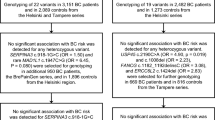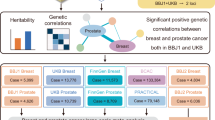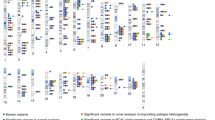Abstract
The common sequence variants that have recently been associated with cancer risk are particular to a single cancer type or at most two. Following up on our genome-wide scan of basal cell carcinoma1, we found that rs401681[C] on chromosome 5p15.33 satisfied our threshold for genome-wide significance (OR = 1.25, P = 3.7 × 10−12). We tested rs401681 for association with 16 additional cancer types in over 30,000 cancer cases and 45,000 controls and found association with lung cancer (OR = 1.15, P = 7.2 × 10−8) and urinary bladder, prostate and cervix cancer (ORs = 1.07−1.31, all P < 4 × 10−4). However, rs401681[C] seems to confer protection against cutaneous melanoma (OR = 0.88, P = 8.0 × 10−4). Notably, most of these cancer types have a strong environmental component to their risk. Investigation of the region led us to rs2736098[A], which showed stronger association with some cancer types. However, neither variant could fully account for the association of the other. rs2736098 corresponds to A305A in the telomerase reverse transcriptase (TERT) protein and rs401681 is in an intron of the CLPTM1L gene.
This is a preview of subscription content, access via your institution
Access options
Subscribe to this journal
Receive 12 print issues and online access
$209.00 per year
only $17.42 per issue
Buy this article
- Purchase on Springer Link
- Instant access to full article PDF
Prices may be subject to local taxes which are calculated during checkout

Similar content being viewed by others
References
Stacey, S.N. et al. Common variants on 1p36 and 1q42 are associated with cutaneous basal cell carcinoma but not with melanoma or pigmentation traits. Nat. Genet. 40, 1313–1318 (2008).
Gudmundsson, J. et al. Genome-wide association study identifies a second prostate cancer susceptibility variant at 8q24. Nat. Genet. 39, 631–637 (2007).
Stacey, S.N. et al. Common variants on chromosomes 2q35 and 16q12 confer susceptibility to estrogen receptor-positive breast cancer. Nat. Genet. 39, 865–869 (2007).
Yeager, M. et al. Genome-wide association study of prostate cancer identifies a second risk locus at 8q24. Nat. Genet. 39, 645–649 (2007).
Haiman, C.A. et al. Multiple regions within 8q24 independently affect risk for prostate cancer. Nat. Genet. 39, 638–644 (2007).
Easton, D.F. et al. Genome-wide association study identifies novel breast cancer susceptibility loci. Nature 447, 1087–1093 (2007).
Tomlinson, I. et al. A genome-wide association scan of tag SNPs identifies a susceptibility variant for colorectal cancer at 8q24.21. Nat. Genet. 39, 984–988 (2007).
Gudbjartsson, D.F. et al. ASIP and TYR pigmentation variants associate with cutaneous melanoma and basal cell carcinoma. Nat. Genet. 40, 886–891 (2008).
Thorgeirsson, T.E. et al. A variant associated with nicotine dependence, lung cancer and peripheral arterial disease. Nature 452, 638–642 (2008).
Eeles, R.A. et al. Multiple newly identified loci associated with prostate cancer susceptibility. Nat. Genet. 40, 316–321 (2008).
Hung, R.J. et al. A susceptibility locus for lung cancer maps to nicotinic acetylcholine receptor subunit genes on 15q25. Nature 452, 633–637 (2008).
Amos, C.I. et al. Genome-wide association scan of tag SNPs identifies a susceptibility locus for lung cancer at 15q25.1. Nat. Genet. 40, 616–622 (2008).
Thomas, G. et al. Multiple loci identified in a genome-wide association study of prostate cancer. Nat. Genet. 40, 310–315 (2008).
Kiemeney, L.A. et al. Sequence variant on 8q24 confers susceptibility to urinary bladder cancer. Nat. Genet. 40, 1307–1312 (2008).
Amundadottir, L.T. et al. A common variant associated with prostate cancer in European and African populations. Nat. Genet. 38, 652–658 (2006).
Haiman, C.A. et al. A common genetic risk factor for colorectal and prostate cancer. Nat. Genet. 39, 954–956 (2007).
Gudbjartsson, D.F. et al. Many sequence variants affecting diversity of adult human height. Nat. Genet. 40, 609–615 (2008).
Yamamoto, K., Okamoto, A., Isonishi, S., Ochiai, K. & Ohtake, Y. A novel gene, CRR9, which was up-regulated in CDDP-resistant ovarian tumor cell line, was associated with apoptosis. Biochem. Biophys. Res. Commun. 280, 1148–1154 (2001).
Blackburn, E.H. Switching and signaling at the telomere. Cell 106, 661–673 (2001).
Wu, X. et al. Telomere dysfunction: a potential cancer predisposition factor. J. Natl. Cancer Inst. 95, 1211–1218 (2003).
Shen, J. et al. Short telomere length and breast cancer risk: a study in sister sets. Cancer Res. 67, 5538–5544 (2007).
Widmann, T.A., Herrmann, M., Taha, N., Konig, J. & Pfreundschuh, M. Short telomeres in aggressive non-Hodgkin's lymphoma as a risk factor in lymphomagenesis. Exp. Hematol. 35, 939–946 (2007).
Risques, R.A. et al. Leukocyte telomere length predicts cancer risk in Barrett's esophagus. Cancer Epidemiol. Biomarkers Prev. 16, 2649–2655 (2007).
Han, J. et al. A prospective study of telomere length and the risk of skin cancer. J. Invest. Dermatol. advance online publication, doi: 10.1038/jid.2008.238 (31 July 2008).
Zhang, A. et al. Genetic alterations in cervical carcinomas: frequent low-level amplifications of oncogenes are associated with human papillomavirus infection. Int. J. Cancer 101, 427–433 (2002).
Kang, J.U., Koo, S.H., Kwon, K.C., Park, J.W. & Kim, J.M. Gain at chromosomal region 5p15.33, containing TERT, is the most frequent genetic event in early stages of non-small cell lung cancer. Cancer Genet. Cytogenet. 182, 1–11 (2008).
Tomlinson, I.P. et al. A genome-wide association study identifies colorectal cancer susceptibility loci on chromosomes 10p14 and 8q23.3. Nat. Genet. 40, 623–630 (2008).
Valdes, A.M. et al. Obesity, cigarette smoking, and telomere length in women. Lancet 366, 662–664 (2005).
Frenck, R.W. Jr ., Blackburn, E.H. & Shannon, K.M. The rate of telomere sequence loss in human leukocytes varies with age. Proc. Natl. Acad. Sci. USA 95, 5607–5610 (1998).
Slagboom, P.E., Droog, S. & Boomsma, D.I. Genetic determination of telomere size in humans: a twin study of three age groups. Am. J. Hum. Genet. 55, 876–882 (1994).
Acknowledgements
We thank the individuals that participated in the study and whose contribution made this work possible. We also thank the nurses at deCODE's participant recruitment center and the personnel at deCODE's core facilities. We acknowledge the Icelandic Cancer Registry for assistance in the ascertainment of the Icelandic subjects with cancer. The project was funded in part by the European Commission (POLYGENE: LSHC-CT-2005-018827 and GENADDICT: LSHM-CT-2004-005166), the National Institutes of Health (R01-DA017932) and a research investment grant of the Radboud University Nijmegen Medical Centre. The Leeds Bladder Cancer Study was funded by Cancer Research UK and Yorkshire Cancer Research. Torino Bladder Cancer Case Control Study was supported by a grant to ECNIS (Environmental Cancer Risk, Nutrition and Individual Susceptibility), a network of excellence operating within the European Union 6th Framework Program, Priority 5: “Food Quality and Safety” (Contract No 513943); and by a grant of the compagnia di San Paolo, the Italian Association for Cancer Research, Italy and the Piedmont Region Progetti di Ricerca Sanitaria Finalizzata. J.H. is supported by the Swedish Cancer Society, The Radiumhemmet Research Funds, The Swedish Research Council and the Karolinska Institutet Research Funds.
Author information
Authors and Affiliations
Contributions
The study was designed and results were interpreted by T.R., P.S., S.N.S., F.G., J.G., J.R.G., D.F.G., A.K., S.T., U.T. and K.S. Statistical analysis was carried out by P.S., F.G., D.F.G., M.L.F., G.T. and A.K. Subject ascertainment, recruitment, biological material collection and collection of clinical and lifestyle information was organized and carried out by T.E.T., K. Kristjansson, S.G.S., R.R., B. Sigurgeirsson, K.T., J.H.O., S.J., H.H., T.G., H.J.I., E.J., T.J., G.V.E., R.B.B., K.R.B., B.A.A., H. Skuladottir, K.O., A. Salvarsdottir, H. Saemundsson, J.H., V.H., E.N., S. Polidoro, S. Porru, R.B.-E., R.K., K.H., P.R., K. Koppova, E.G., G.S., D.T.B., A.E.K., M.C., E.K., M.P.Z., P.V., P.d.V., G. Matullo, A.F., D.I., M.J.V., R.A., B. Saez, P.J., J.B., S.N., A.T., D.K., A.L., F.d.V., F.B., W.J.C., J.A.S., H.F.M.v.d.H., H.J.S., R.A.T., E.O., O.v.H., K.K.H.A., J.I.M., L.A.K. Principal collaborators for the non-Icelandic populations were L.A.K. (The Netherlands), J.I.M. (Zaragoza, Spain), A.E.K. (UK), G. Matullo and P.V. (Torino), S.P. (Brescia), M.P.Z. and F.B. (Belgium), R.K. (Eastern Europe), G.S. (bladder cancer, Sweden), J.H. (melanoma, Sweden), E.N. (Valencia, Spain) and W.J.C. (Chicago, USA). Genotyping and laboratory experiments were carried out by A. Sigurdsson, T.B., M.J., H.H., H.B., M.A., K.T.K. and S.M. Bioinformatic analysis was carried out by P.S., T.R., A. Sigurdsson, T.E.T., G. Masson, T.B. and G.T. Authors T.R., P.S., D.F.G., A.K., U.T. and K.S. drafted the manuscript. All authors contributed to the final version of the paper.
Corresponding authors
Ethics declarations
Competing interests
The authors from deCODE Genetics are shareholders in deCODE Genetics Inc. and therefore declare competing financial interest.
Supplementary information
Supplementary Text and Figures
Supplementary Methods, Supplementary Note, Supplementary Tables 1–11 and Supplementary Figures 1 and 2 (PDF 229 kb)
Rights and permissions
About this article
Cite this article
Rafnar, T., Sulem, P., Stacey, S. et al. Sequence variants at the TERT-CLPTM1L locus associate with many cancer types. Nat Genet 41, 221–227 (2009). https://doi.org/10.1038/ng.296
Received:
Accepted:
Published:
Issue Date:
DOI: https://doi.org/10.1038/ng.296
This article is cited by
-
TERT single nucleotide polymorphism rs2736098 but not rs2736100 is associated with telomere length in HIV-infected patients on cART
Molecular Biology Reports (2024)
-
Multi-ancestry genome-wide meta-analysis identifies novel basal cell carcinoma loci and shared genetic effects with squamous cell carcinoma
Communications Biology (2024)
-
Role of DNA methylation in the relationship between glioma risk factors and glioma incidence: a two-step Mendelian randomization study
Scientific Reports (2023)
-
The role of SOD2 and NOS2 genes in the molecular aspect of bladder cancer pathophysiology
Scientific Reports (2023)
-
Ethnicity-specific association between TERT rs2736100 (A > C) polymorphism and lung cancer risk: a comprehensive meta-analysis
Scientific Reports (2023)



